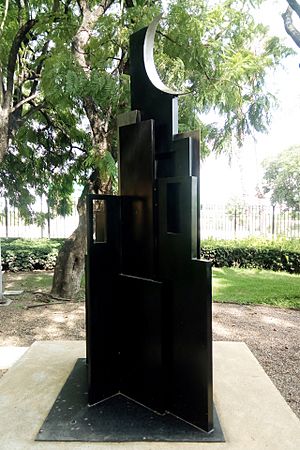Naomi Siegmann facts for kids
Naomi Siegmann (born in New York in 1933 – died February 28, 2018, in Mexico City) was an American artist. She became famous for making sculptures of everyday objects but showing them in surprising ways. She moved to Mexico with her family and started her art career there, learning to carve wood.
For about 20 years, she worked with wood. Later, she began using other materials, including recycled items, because she cared about the environment. Naomi Siegmann had her own art shows in Mexico and the United States. She also took part in group shows in these countries and in Europe. She was asked to create large sculptures in both Mexico and the U.S. Her amazing work earned her a spot in the important Salón de la Plástica Mexicana.
Contents
Naomi Siegmann's Life Story
Naomi Siegmann was born in New York in 1933. In 1960, she moved to a small town in Mexico called Santa Rosa de Múzquiz with her husband and two young children. Her husband worked in mining there.
She felt a strong urge to create with her hands. So, she taught herself how to model clay. Later, her sister taught her the basics of wood carving.
After a few years, she moved back to Mexico City. This became her permanent home, and she lived there for the rest of her life.
Her first formal art training was in Mexico City. She studied with the sculptress Tosia Malamud. She also took a workshop with Enrique Miralda. To learn more, she traveled to places like East Africa, Japan, South America, and Europe.
Naomi Siegmann passed away on February 28, 2018. She had pneumonia complications. A few weeks before, she had fallen and broken her hip. She could not fully recover from her lung problems.
Her Art Career
Naomi Siegmann spent most of her career creating art in Mexico. She had many solo art shows. Some of these were at the Centro Cultural Tamaulipas (2013) and the Centro Médico Nacional Siglo XXI (2013). She also showed her work at the Centro Cultural Isidro Fabela in Mexico City several times.
Her art was also displayed at the Canal Street Gallery in Houston (2010). She had shows at the Instituto Cultural de México in San Antonio (2010). In Mexico City, her work was seen at the San Francisco Church (2009).
She participated in more than 75 group art shows. These shows took place in Mexico, the United States, and Europe.
Special Projects and Awards
From 2001 to 2006, Siegmann led a special art and environment project. It was called El Bosque/The Forest. She worked with 14 other sculptors. They created trees from materials other than wood. The goal was to encourage planting more trees. This project happened in four cities in Mexico and four in the United States.
In 2010, she won an award called Puertas Caminos de la Justicia 200 Años. This award came from the Supreme Court of Justice of the Nation.
Where Her Art Can Be Found
Naomi Siegmann's artwork is part of many important collections. You can find her pieces at the Museo de Arte Moderno in Mexico City. The National Autonomous University of Mexico also has her work.
Her art is also in the FEMSA collection in Monterrey. The Aldrich Contemporary Art Museum in Connecticut has some of her sculptures. Other places include the Whitken Gallery in New York and the Yad Vashem Museum in Jerusalem.
Her work has also been featured in several books. These include XX Century Dictionary of Mexican Sculpture (1984) and Naomi Siegmann (2014).
She was a proud member of the Salón de la Plástica Mexicana.
Her Artistic Style
Naomi Siegmann started carving wood in the 1970s. She worked with wood for about 20 years. In the 1990s, she began trying out metal. She used old molds from a factory with another artist, Inmaculada Barca.
She switched materials for two reasons. First, she was interested in new ways to create. Second, she worried that using too much wood harmed forests. Since then, she used bronze, steel, and paper. More recently, she worked with recycled and found materials. Since the 2000s, much of her art has focused on plants and trees. This came from her thoughts about nature and human survival.
Mexican Influence and Hyperrealism
As she developed her art in Mexico, her work took on Mexican colors and culture. This included ancient Mexican art and history. Many of her sculptures show a real, everyday object. But she places it outside its normal setting. This makes people look at it in a new way.
Her art has been called "hyper realistic." This means it looks extremely real. She also called it “abstracted realism.” Even though her sculptures are still and solid, they show all the movement and shape of the real thing. For example, a sculpted towel will have all the folds of a real one, but it won't move. In a series called “Clothesline,” she made Mexican clothes that looked like they were blowing in the wind.
Installations and Monumental Works
In the new millennium, she created large art installations. One was "Realidad Alterada" ("Altered Reality") in 2011. It was a garden made from recycled tires. Another was "Lluvia de jacarandas" ("Seed Rain") in 2003. This piece showed a rain of jacaranda seeds. Both could be made to fit large spaces.
Most of her art was life-sized. But she also made very large sculptures from steel and bronze. She created a mural at the National Auditorium in Mexico City. These big works include a welded steel dinosaur for the Papalote Children's Museum. She also made a steel piece for Mt. Grey High School in Williamstown, Massachusetts. Two other six-meter abstract works are at the ABC Hospital and the Universidad Autonoma Metropolitana in Mexico City.
See also
 In Spanish: Naomi Siegmann para niños
In Spanish: Naomi Siegmann para niños


